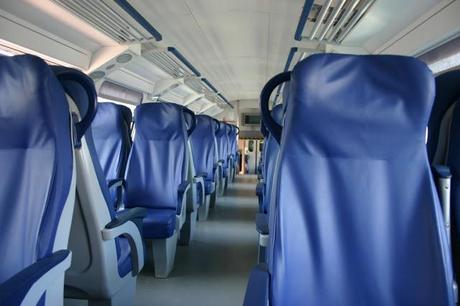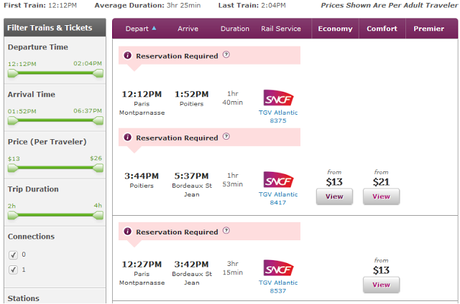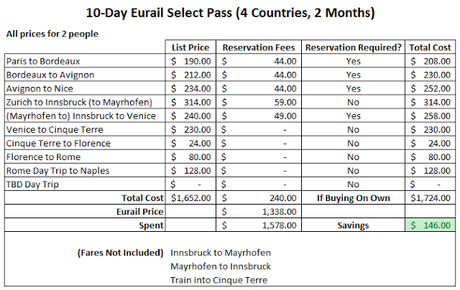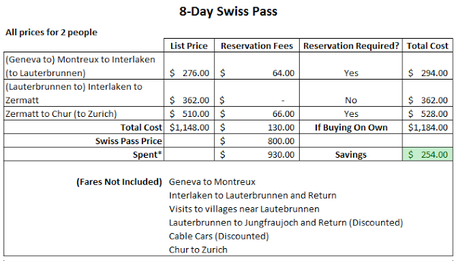 For our next stay in Europe, we purchased a 10-segment Eurail Select Pass that is valid in 4 countries (France, Switzerland, Austria, and Italy) over a period of two months. Our last assessment into this topic showed that our route was cost effective for the ten most expensive rail segments out of the fourteen we are planning to take. However, since purchasing our rail pass we realized one little error that we did not account for in our first analysis, and that it is the major headache (and cost) that comes with making reservations for seat assignments ahead of time. (Photo "Subway Station" by Krappweis)
For our next stay in Europe, we purchased a 10-segment Eurail Select Pass that is valid in 4 countries (France, Switzerland, Austria, and Italy) over a period of two months. Our last assessment into this topic showed that our route was cost effective for the ten most expensive rail segments out of the fourteen we are planning to take. However, since purchasing our rail pass we realized one little error that we did not account for in our first analysis, and that it is the major headache (and cost) that comes with making reservations for seat assignments ahead of time. (Photo "Subway Station" by Krappweis)Now that we have made most of our reservations, we realized that there are a lot of subtle intricacies required when booking reservations with a Eurail Pass. Since the need for reservations and their corresponding fees aren't necessary for everyone, this guide was born. For those like us who are traveling during peak season or are uneasy with winging it for popular rail routes, this one is for you.
When to Reserve a Seat, Or Not?

For the most part, it is a fairly popular thought that you do not have to make a reservation for a train in Europe at any time of the year. As we will be traveling in peak season in some of the most heavily visited countries in the continent, we often look at that statement with a bit of bewilderment. Hostels book up months in advance, surely the trains are no better. Blame our adverseness to risk, or our need to get out of the Schengen Zone fast, but getting stuck in a city for an extra few hours or days was not something we could consider. (Photo "Inside the Train" by pilueze)
Since we decided to reserve as many trains in advance as we could, we actually discovered a few facts that are useful for all travelers on the Eurail system. All of which deal with the often overlooked detail of seat reservations.
1. Mandatory Reservations
There are many cases when a reservation on a train is compulsory for all travelers, not just holders of a rail pass. These are cases where you are on a high speed train like our Paris to Bordeaux route, an overnight train with sleeper cabin, premium lines like our Panoramic Trains in Switzerland, or other low-frequency, high-demand routes. As is the case with all reserved trains, the number of tickets allocated to rail pass holders is low, and if you miss it you will be out of luck!
2. Possible to Reserve, Non-Resevation Sections Available
Apart from the premium trains above, most of the more conventional trains in Europe operate under a structure of combining reserved and non-reserved seating sections. In this setup only a fraction of the cars on these trains will be available for early reservations with seat assignments. In similar fashion, the number of tickets allocated for rail passes holders is limited. But where you would be out of luck in a premium train, you may have no issue showing up the day of departure and getting a ticket for the non-reserved seating section while using your rail pass.
The issue with this option is determining just how many seats are in the non-reserved category as this is a number that is not often published for a specific route. If my trip to Japan with the JR Pass was any indication of a comparable setup in Europe, walking on even the most popular routes is likely a non-issue.
3. No Reservations Required or Allowed
In a third category of trains, especially when the route is on a domestic line and of short duration, you simply cannot reserve a seat at all. The perk with these train routes is that in their short duration they are also met with more frequent departures, making the ability to get a seat an easy task. If on the off chance a train is full when you get there, the next one is likely only 30 to 60 minutes away.
So what does this all mean for you as a rail pass traveler? Mass confusion.
In trying to determine which trains are required to book in advance, not required but highly recommended, or are completely free to travel without reservation, we gave up. The issue is not so much finding information, but rather that you'll find page after page of conflicting information as you go. One source says there is non-reserve seating, others say it is compulsory. One traveler says they got on no problem, another had an issue and missed a day of traveling because of it. After all of the stress and hours of research, we decided just to book them all to get it over with.
Even with such a blanket decision, the headaches had only just begun.
Many Booking Services Exist, Few Are Useful

One of the frustrations we had with using our Eurail Pass was figuring out where we could reserve our tickets. Sure, 3rd party sites exist that let you reserve seats for just about every country, but their reservation fees also include a premium for their service. In trying to be thrifty we wanted to source as many "minimal fee" tickets in advance as we were traveling during peak season on many busy routes in Europe.
You'd think that in this day there would be an easier system for reserving tickets, but there is not. The theme of information overload like in the previous section is just as true in the booking process.
As it turns out, each country offers their own "official" booking service for sourcing tickets in advance and their rules are all different. Some can only be done at train stations while others can be done online. A few can be done online, but only if you are traveling domestically and not crossing a border. Others have a phone service but require calls to an international number, several minutes on hold, and their own set of rules like the previous categories. The worst case, as we found out with a few online services, is that the booking process works for regular tickets, but the category for a rail pass reservation is just not even offered!
Since you will likely not be in Europe 60 to 90 days before your intended departure date (when tickets go live), able to hold indefinitely on international calls, or travel on pure domestic routes every single train ride, you will likely be out of luck in booking in advance without a premium 3rd party service a good majority of the time.
If we would have accepted that at the beginning, our headaches would not have happened.
Where to Book
We found ourselves booking with Rail Europe quite frequently for our seat reservations as they were convenient, easy to use, and had options that matched our rail pass criteria exactly. The downside to the use of Rail Europe was that there was a hefty reservation fee attached, typically $13 per ticket. In addition, Rail Europe had a 2nd day shipping requirement for all tickets, adding another $18 per order onto the price of a reservation to ship our tickets to our home in the USA. For every unique booking requiring shipping, add a minimum of $44 onto your order. Factor that out over a handful of reservations, and your passes cost savings just got diminished.
Other than Rail Europe, a number of private and government run websites are available for travelers who meet certain criteria. A few we discovered during our booking process are the following:
- Switzerland Rail
- Swiss Panorama Trains (Golden Pass, Glacier Express) - Able to make reservations online using a Swiss Pass with no issue (see Disclaimer at end of post)
- German Rail - Able to book online for segments without a Eurail pass. Unable to reserve over the phone for Eurail Pass for border crossings although other sources suggested it was possible.
- Italian Rail - Although we could book online, we have not decided to make reservations in advance due to our itineraries being relatively short and frequent legs.
One of the most surprising things we saw with booking through Rail Europe was that the Eurail pass reservations did not seem to sell out within a relatively quick period of time after going live. Compare that to how we booked tickets in Spain on our honeymoon last year via RENFE where the super discounted tickets would book within an hour of them becoming available and you'll see two completely different scenarios. What this meant is that you may be able to combine ticket purchases over the period of a few weeks while routes become available to save on the shipping costs, if you are willing to risk it. Based on all the discussions I had with customer service reps at Rail Europe, it is not recommended.
But Does a Rail Pass Still Save Money?
In our previous assessment we did a case study for a travel itinerary on the cost effectiveness of the Eurail pass. We claimed this case study was a reader brought case, but was in fact our own itinerary that we had not announced at the time. Revisiting the case, we need to adjust our numbers some to account for the reservation fees that we had incurred and ignored in our last analysis.

As you can see from the above analysis into the Eurail Pass, even with a few cheap dates we are coming out roughly $150 ahead of what we could have spent. We spent $1,578 out of pocket while we would have had to spent roughly $1,724 if purchasing on our own. Not a huge savings, but enough to add another day onto our itinerary! Although our actual booked segments varied a bit from our original plan in the first assessment, we will be coming out ahead like we predicted.
For comparison, all list price tickets were the actual booking price for the same ticket on the same days we made our reservation (most prices are reflective of a discount from early booking). In this case, for those booking tickets at the last minute you may want to keep in mind that the price you will pay will likely be more. If the ticket required a reservation we added $18 onto the purchase price to reflect Rail Europe's shipping cost only, which may not be as much for traveler's booking on their own on a country specific site. Our calculated savings also does not include the cost of a second day trip that we have not decided on just yet, as is noted above, and will increasing our savings even further.

You may be wondering why we are showing an 8-Day Swiss Pass in this analysis now, without making mention of it before. Our original Eurail pass purchased as a Europe Select Pass for 10 segments throughout France, Switzerland, Austria, and Italy over a period of 2 months. After purchasing the pass, we received a complimentary Swiss Pass from the Switzerland Tourism board for use in our time in the country later this year. This pass allows access to the premium panorama trains that we otherwise would not have taken as well as deeper discounts on cog rails and cable cars (not included in the savings assessment).
To deviate from our original plans, some of our Switzerland segments were removed from our Eurail pass and replaced with cheaper routes and the to-be-determined day trip to use all 10 segments that we paid for. If we would have been on our original itinerary with the Eurail pass our savings would have been even higher due to the expensive nature of traveling in Switzerland. Although our savings with the Swiss Pass would be quite large had we bought it ourselves (~$250), what is not factored into this assessment is the number of smaller routes that will also be included, the upgrade to the premium trains over the Eurail Pass, and significantly steeper discounts on the mountain railways and cable cars. Because of this, our Swiss Pass will be saving us a significant amount of money that cannot truly be captured yet.
Still, no matter how you look at it, we're coming out ahead. Exactly what the Eurail Pass is designed to do, headaches and all.
Did you travel Europe with a Eurail Pass? What did you think? Did you have a similar issue with booking reservations in advance like us or did you wing it? Let us know your story by commenting below!

